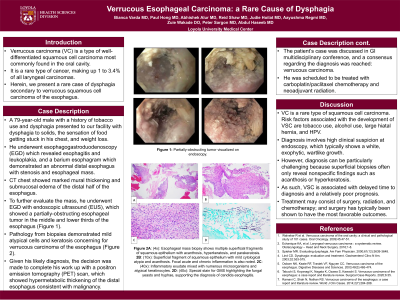Sunday Poster Session
Category: Esophagus
P0449 - Verrucous Esophageal Carcinoma: A Rare Cause of Dysphagia
Sunday, October 22, 2023
3:30 PM - 7:00 PM PT
Location: Exhibit Hall

Has Audio
.jpg)
Bianca Varda, MD
Loyola University Medical Center
Chicago, IL
Presenting Author(s)
Bianca Varda, MD1, Paul Hong, MD1, Abhishek Alur, MD2, Reid Shaw, MD1, Judie Hoilat, MD1, Aayushma Regmi, MD1, Zuie Wakade, DO1, Peter Sargon, MD1, Abdul Haseeb, MD2
1Loyola University Medical Center, Chicago, IL; 2Loyola University Medical Center, Maywood, IL
Introduction: Verrucous carcinoma (VC) is a type of well-differentiated squamous cell carcinoma most commonly found in the oral cavity. It is a rare type of cancer, making up 1 to 3.4% of all laryngeal carcinomas. Herein, we present a rare case of dysphagia secondary to verrucous squamous cell carcinoma of the esophagus.
Case Description/Methods: A 79-year-old male with a history of tobacco use and dysphagia presented to our facility with dysphagia to solids, the sensation of food getting stuck in his chest, and weight loss. He underwent esophagogastroduodenoscopy (EGD) which revealed esophagitis and leukoplakia, and a barium esophagram which demonstrated an abnormal distal esophagus with stenosis and esophageal mass. Imaging was obtained to further characterize the findings. CT chest showed marked mural thickening and submucosal edema of the distal half of the esophagus.
To further evaluate the mass, he underwent EGD with endoscopic ultrasound (EUS), which showed a partially-obstructing esophageal tumor in the middle and lower thirds of the esophagus. Pathology from biopsies demonstrated mild atypical cells and keratosis concerning for verrucous carcinoma of the esophagus. Given his likely diagnosis, the decision was made to complete his work up with a positron emission tomography (PET) scan, which showed hypermetabolic thickening of the distal esophagus consistent with malignancy. The patient’s case was discussed in GI multidisciplinary conference, and a consensus regarding the diagnosis was reached: verrucous carcinoma. He was scheduled to be treated with carboplatin/paclitaxel chemotherapy and neoadjuvant radiation.
Discussion: VC is a rare type of squamous cell carcinoma. Risk factors associated with the development of VSC are tobacco use, alcohol use, large hiatal hernia, and HPV. Diagnosis involves high clinical suspicion at endoscopy, which typically shows a white, exophytic, wartlike growth. However, diagnosis can be particularly challenging because superficial biopsies often only reveal nonspecific findings such as acanthosis or hyperkeratosis. As such, VSC is associated with delayed time to diagnosis and a relatively poor prognosis. Treatment may consist of surgery, radiation, and chemotherapy; and surgery has typically been shown to have the most favorable outcomes.

Disclosures:
Bianca Varda, MD1, Paul Hong, MD1, Abhishek Alur, MD2, Reid Shaw, MD1, Judie Hoilat, MD1, Aayushma Regmi, MD1, Zuie Wakade, DO1, Peter Sargon, MD1, Abdul Haseeb, MD2. P0449 - Verrucous Esophageal Carcinoma: A Rare Cause of Dysphagia, ACG 2023 Annual Scientific Meeting Abstracts. Vancouver, BC, Canada: American College of Gastroenterology.
1Loyola University Medical Center, Chicago, IL; 2Loyola University Medical Center, Maywood, IL
Introduction: Verrucous carcinoma (VC) is a type of well-differentiated squamous cell carcinoma most commonly found in the oral cavity. It is a rare type of cancer, making up 1 to 3.4% of all laryngeal carcinomas. Herein, we present a rare case of dysphagia secondary to verrucous squamous cell carcinoma of the esophagus.
Case Description/Methods: A 79-year-old male with a history of tobacco use and dysphagia presented to our facility with dysphagia to solids, the sensation of food getting stuck in his chest, and weight loss. He underwent esophagogastroduodenoscopy (EGD) which revealed esophagitis and leukoplakia, and a barium esophagram which demonstrated an abnormal distal esophagus with stenosis and esophageal mass. Imaging was obtained to further characterize the findings. CT chest showed marked mural thickening and submucosal edema of the distal half of the esophagus.
To further evaluate the mass, he underwent EGD with endoscopic ultrasound (EUS), which showed a partially-obstructing esophageal tumor in the middle and lower thirds of the esophagus. Pathology from biopsies demonstrated mild atypical cells and keratosis concerning for verrucous carcinoma of the esophagus. Given his likely diagnosis, the decision was made to complete his work up with a positron emission tomography (PET) scan, which showed hypermetabolic thickening of the distal esophagus consistent with malignancy. The patient’s case was discussed in GI multidisciplinary conference, and a consensus regarding the diagnosis was reached: verrucous carcinoma. He was scheduled to be treated with carboplatin/paclitaxel chemotherapy and neoadjuvant radiation.
Discussion: VC is a rare type of squamous cell carcinoma. Risk factors associated with the development of VSC are tobacco use, alcohol use, large hiatal hernia, and HPV. Diagnosis involves high clinical suspicion at endoscopy, which typically shows a white, exophytic, wartlike growth. However, diagnosis can be particularly challenging because superficial biopsies often only reveal nonspecific findings such as acanthosis or hyperkeratosis. As such, VSC is associated with delayed time to diagnosis and a relatively poor prognosis. Treatment may consist of surgery, radiation, and chemotherapy; and surgery has typically been shown to have the most favorable outcomes.

Figure: Figure 1: Partially-obstructing tumor visualized on endoscopy.
Disclosures:
Bianca Varda indicated no relevant financial relationships.
Paul Hong indicated no relevant financial relationships.
Abhishek Alur indicated no relevant financial relationships.
Reid Shaw indicated no relevant financial relationships.
Judie Hoilat indicated no relevant financial relationships.
Aayushma Regmi indicated no relevant financial relationships.
Zuie Wakade indicated no relevant financial relationships.
Peter Sargon indicated no relevant financial relationships.
Abdul Haseeb indicated no relevant financial relationships.
Bianca Varda, MD1, Paul Hong, MD1, Abhishek Alur, MD2, Reid Shaw, MD1, Judie Hoilat, MD1, Aayushma Regmi, MD1, Zuie Wakade, DO1, Peter Sargon, MD1, Abdul Haseeb, MD2. P0449 - Verrucous Esophageal Carcinoma: A Rare Cause of Dysphagia, ACG 2023 Annual Scientific Meeting Abstracts. Vancouver, BC, Canada: American College of Gastroenterology.
